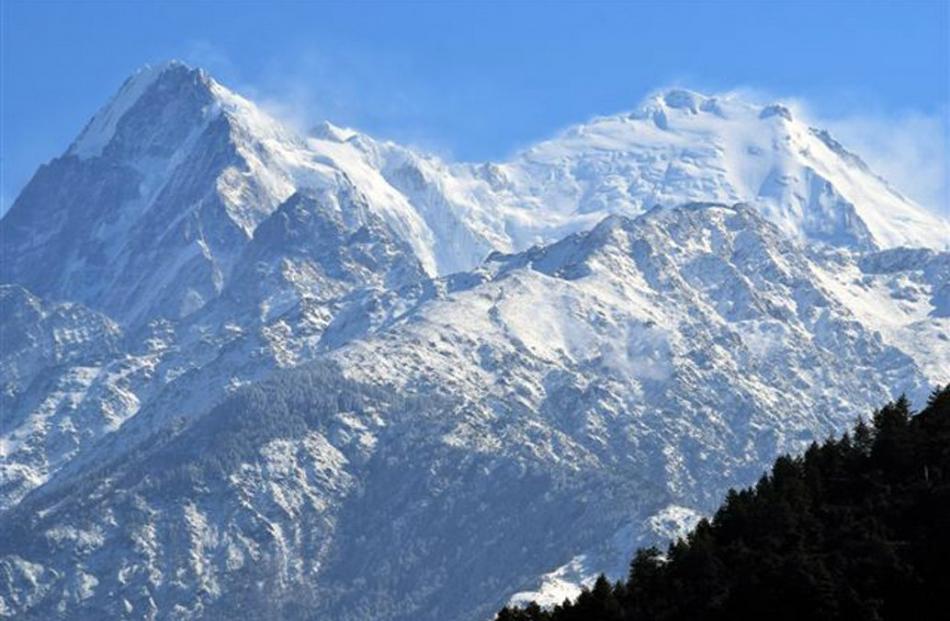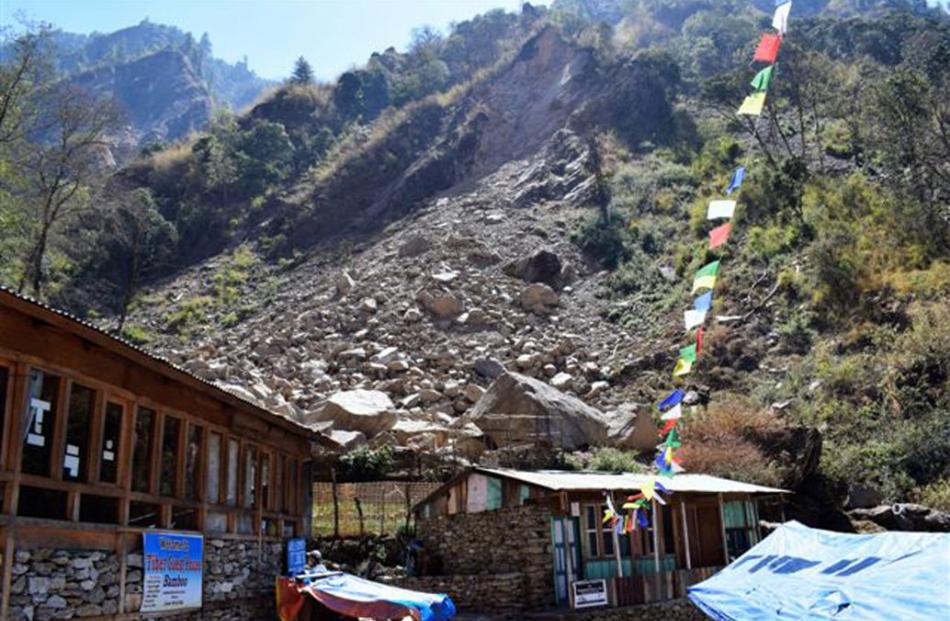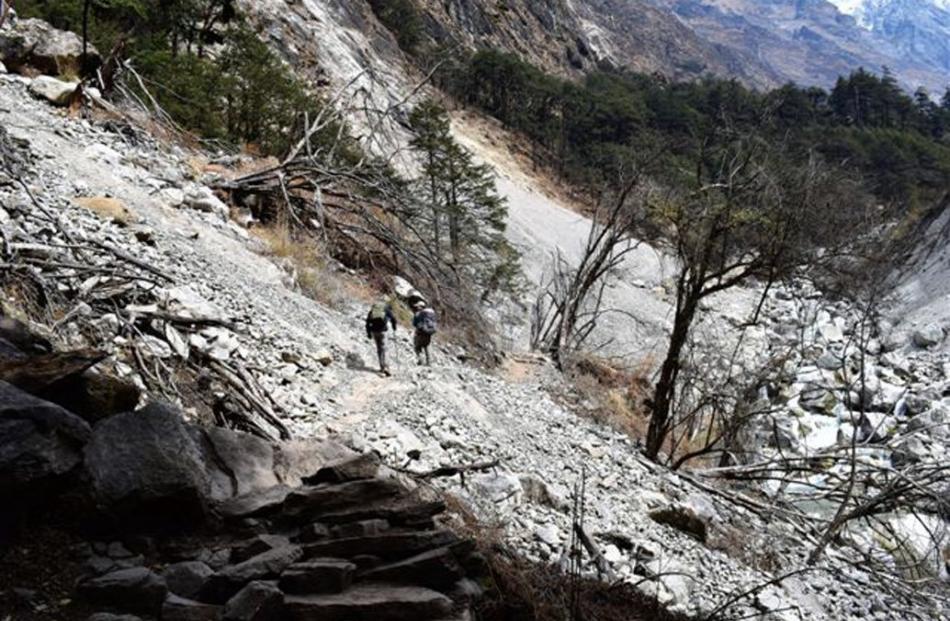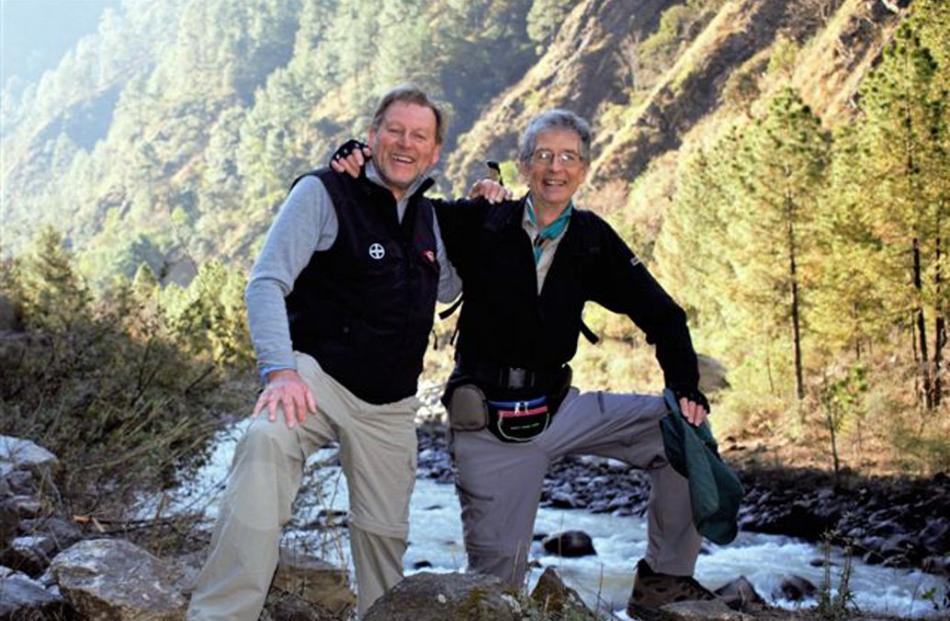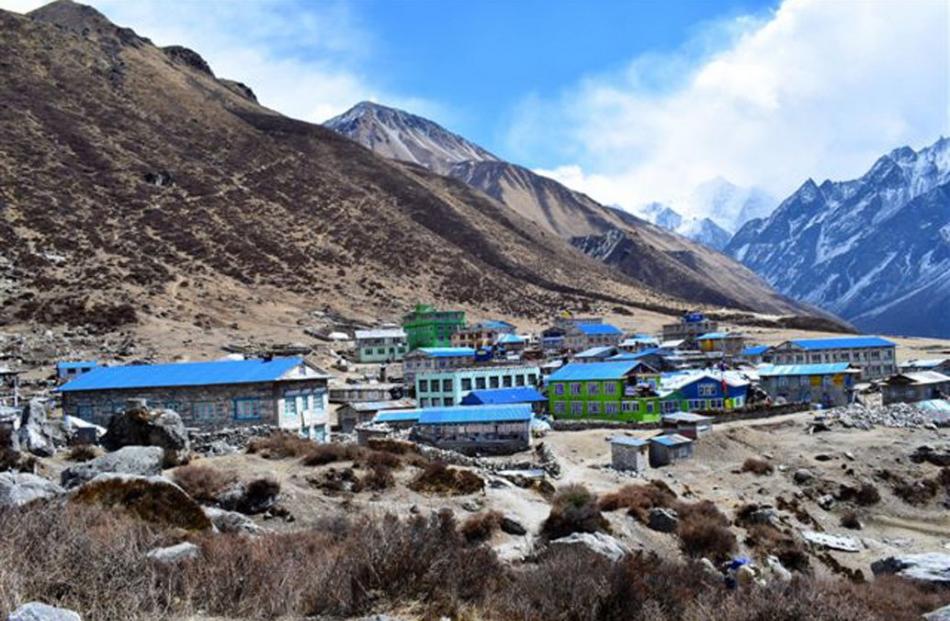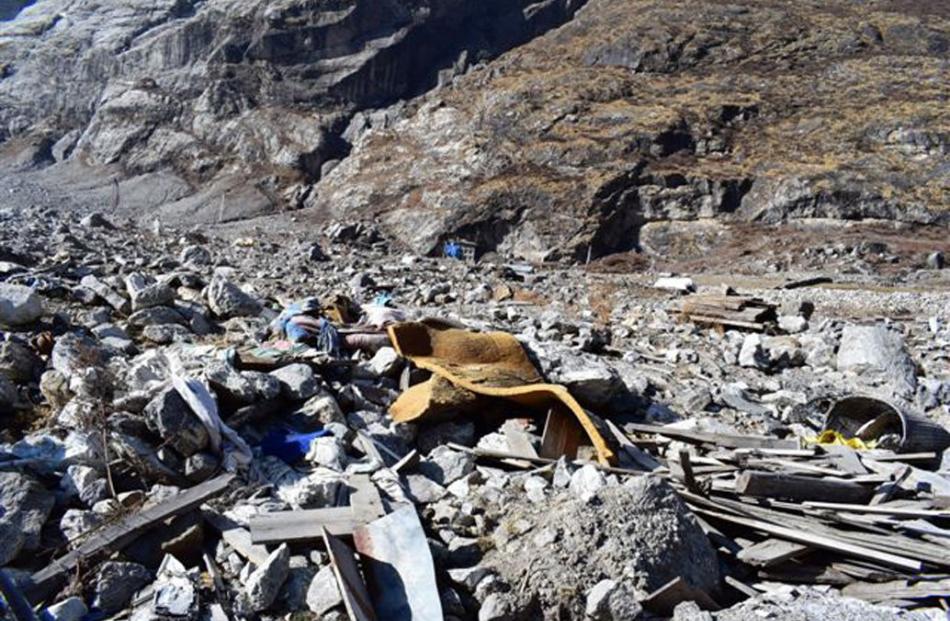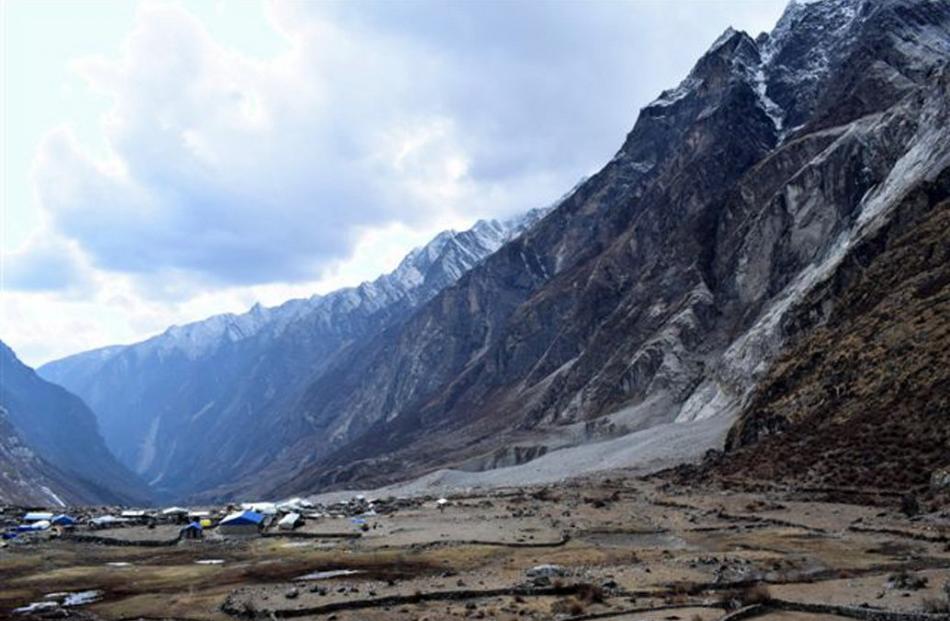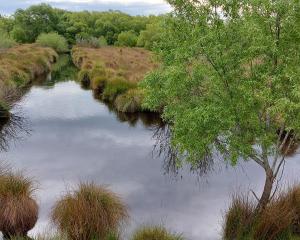On the second anniversary of a massive earthquake in Nepal, Andrew Waterworth, of Wanaka, reflects on his recent trekking adventure in the Langtang Valley.
When Harry, an old university friend, wrote asking if anyone wanted to join him on a trek in Nepal I jumped at the chance.
The last time I had trekked there was more than 30 years ago and, with both of us now in our 60s, retired, respective children flown the nest, I thought what better way to test the mantra ``60 is the new 50''.
I knew the six-day trek would test me physically, but what I didn't know was how much it would affect me emotionally.
Our guide, Tek Rai, had recommended a route through Langtang Valley, the third most popular trek in the country before April 25, 2015.
On that day a 7.8-magnitude earthquake shattered Nepal. Its epicentre was just south of Langtang Valley and an entire village, one of the most popular stops on the trek, was buried by a huge landslip.
It was less than two years since the quake had struck so we wondered if this was the trek for us, but Tek assured us the route was open.
At Kathmandu airport we found Tek waiting for us. He took us to our first night's accommodation, the Kathmandu Guest House and met us the next morning with his porter Arjun.
We loaded our gear into a four-wheel-drive and set off for Syabrubesi, 80km north of the city.
As we headed further up into the mountains, the roads got worse and worse - potholed, dusty and clinging to precipitous mountain edges.
By the time we arrived at our modest hotel eight hours later, we felt like we'd been shaken, rattled and jolted non-stop.
Harry and I had dinner in the hotel restaurant - we were the only diners - and opted for an early night, knowing the next day was going to be a real test of our fitness.
Our trek was to take us into Langtang National Park along Langtang River Valley, parallel with the Tibet/China border, in the shadow of the mighty peaks of Langtang II (6596m) and Langtang Lirung (7227m).
The plan was to hike three days to the village of Kyanjin and then return by the same route.
The Langtang trail was rated moderate to challenging for people of reasonable fitness and looking up the valley ahead I hoped my weekly tramps up Mt Iron in Wanaka would be enough to prepare me for the days ahead.
Day 1
For the first two hours we hiked along the valley until we reached Pairo, where we stopped for morning tea.
A sign on the tea house said 1700m, which meant we'd only climbed 200m, and we had another 900m to ascend by the end of the day.
We'd seen several landslips, evidence of the 2015 earthquake and why it had caused the closure of the track for over a year.
The next two hours took us through alpine forests including patches of rhododendrons with a few in early bloom.
At noon, we reached our lunch stop, Bamboo Guest House at 1900m.
I ordered macaroni cheese and black tea. Less than two years after the earthquake, many teahouses and restaurants are open for business with a surprising range of food and drinks.
We kept reminding ourselves there are no roads or airports up here. Everything comes up on people's backs, occasionally by donkey.
As we waited for our food, we got a first-hand look at the destructive power of the earthquake.
A landslip had hurtled down the mountain directly towards the guest house, tumbling boulders the size of cars like dice. Some had come to rest a mere 30m from where we were eating, crushing two of the guest house's cabins.
After lunch, we crossed the Langtang River and for the next two and a-half hours it was a lung and leg-busting hike up to Rimchi at 2399m.
The weather was superb so we had stunning blue skies and picture postcard views to inspire us while below, the rushing, tumbling Langtang River roared its way through a mass of giant rocks and boulders.
It wasn't long before we crossed another landslip, following a narrow path just wide enough for a person or a donkey. Tek advised us not to linger as rock falls were common and potentially dangerous.
As we climbed higher and steeper, I began to noticeably slow down. Altitude was kicking in and Tek called a halt for tea and biscuits.
We reached our first night's destination, Lama Hotel at 2500m about 4pm.
There was a tremendous sense of achievement. It might only be ``Day 1'' but it had been a big day as we'd climbed 1100m.
Amazingly, they had hot showers thanks to solar power. Many of the guest houses had solar panels to provide electricity and to heat water for trekkers, although it was weather dependent.
Dinner was garlic and potato omelette with Tibetan bread and ginger tea.
I slept fitfully and needed multiple visits to the loo, all normal at altitude, but it meant I was tired and groggy the next morning and that day we had another 900m to climb.
Day 2
We were on the trail by 8am, another brilliant blue-sky sunny day.
We took it slow and steady, stopping regularly to drink water, as between three and five litres a day is recommended at altitude.
As we headed up the valley, we had awe-inspiring views of Langtang Lirung's towering 7227m peak.
Lunch was at Thyangsyap, a guest house at 3140m, a popular stop for trekkers.
We met a German father with his grown son and daughter who were heading back as the father had altitude sickness.
He was not the first or last we were to meet suffering the effects. Later we saw a young Spanish woman being taken down on a donkey, too ill to walk.
From here we had another 200m to 300m ascent before we would reach the former village of Langtang and as we approached, the scale of the disaster became apparent.
According to the US Geological Survey the debris avalanche that destroyed Langtang village was the largest and most destructive landslip caused by the Nepal earthquake.
The quake unleashed an avalanche of snow and ice high on the slopes of Langtang Lirung which gathered speed and debris before it launched off a 1000m-high cliff directly above the village.
The people didn't stand a chance. What wasn't buried by the massive landslip was flattened by the accompanying air blast.
It's been likened to an atomic bomb detonated above the village. Looking across the valley there were forests of trees, laid flat like corpses, all pointing in the same direction.
More than 300 people died at Langtang, 175 villagers and at least 125 visitors: guides, porters and trekkers.
What made the scene even more poignant was knowing that the majority of the bodies were never recovered, buried up to 50m deep beneath the massive pile of rocky debris.
With each step on the barren and desolate ground our thoughts turned to that day in April 2015 when the landslip obliterated everything in its path, crushing the victims, entombing them beneath our feet.
As well as the village of Langtang, the landslip destroyed a military outpost and a monastery. Prayer flags fluttered in the wind, carrying thoughts and prayers for those who died here.
That night we stayed at the Flavour Guest House just past Langtang at 3450m.
Tek told us many people left the valley for good after the earthquake, the pain and the prospect of rebuilding their lives too much to bear.
Tourism was the lifeblood of Langtang Valley's economy and the people who stayed are doing everything possible to re-open accommodation and restaurants to encourage visitors to return.
Day 3
We experienced this at first hand the next day at our final destination, Kyanjin, three hours' hike up the valley.
We arrived in late morning and a woman waiting by the path asked if we would stay at her guest house, the Evening View.
Tek explained the guest house was destroyed in the earthquake and in the past year the woman and her husband had put every rupee they had into rebuilding.
We learned our host's name was Dawa Chenjum Tamang and like many people in this region she was of Tibetan origin.
She had a small Buddhist shrine in the dining room which she tended as we tucked into her garlic soup and fried potatoes.
Warm and full, we looked out and saw clouds beginning to swirl around the mountain peaks.
We had reached our journey's goal at 3830m and it was if they were telling us it was time to head back.
The next morning there was snow on the ground and our trek back to Syabrubesi was through a very different-looking landscape, ethereal, ghostly and beautiful.
This was the Himalaya I remembered from 30 years ago, one that can change moods in a moment.
For the people of Langtang Valley, their lives changed forever that day in April 2015 but with guides like Tek Rai bringing in visitors and spreading the word that the Langtang trail is open, tourism will bring back life, livelihoods and a future for this beautiful valley.
Check list
Airline: China Southern Airlines, Auckland to Kathmandu via Guangzhou
Trekking company: Himalayan Trekking Dreams Pty Ltd
Guide: Tek Rai
Trek duration: Six days
Accommodation in Kathmandu: Kathmandu Guest House
Earthquake facts
Time: 11.56am on April 25, 2015
Depth: 12km
Magnitude: 7.8
Fatalities: Nearly 9000
Injured: 22,309
Buildings damaged or destroyed: More than 800,000. All seven Unesco World Heritage sites suffered damage
Families made homeless: 500,000
Impact on tourism: In 2014, an estimated 800,000 tourists visited Nepal. The number of arrivals dropped by about 30% in 2015, according to Nepal’s Department of Tourism. Before the quake, around 15,000 tourists used to visit the Langtang area each year.

